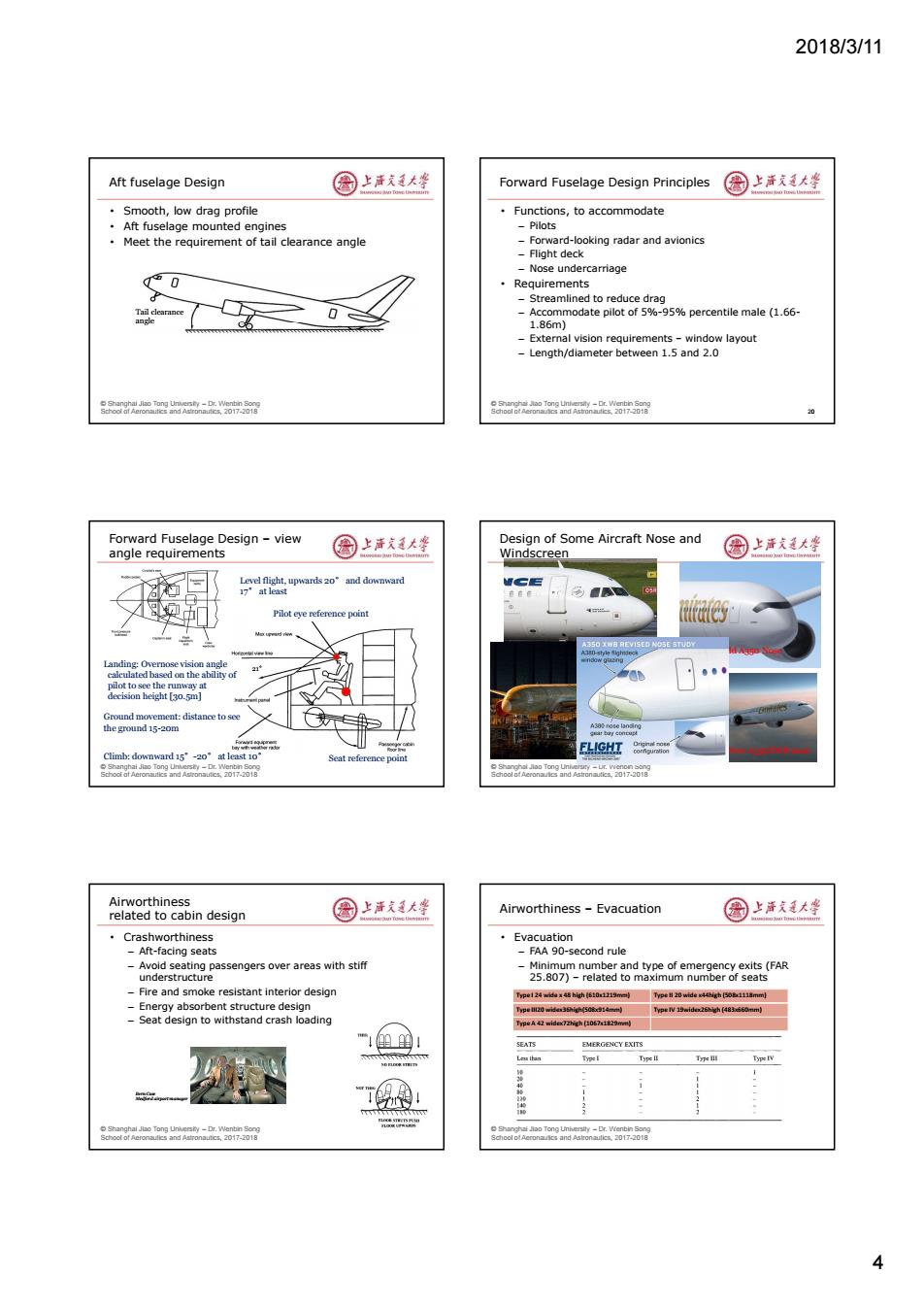正在加载图片...

2018/3/11 Aft fuselage Design 因上声天大学 Forward Fuselage Design Principles 国上清大学 Smooth,low drag profile Functions,to accommodate Aft fuselage mounted engines -Pilots Meet the requirement of tail clearance angle Forward-looking radar and avionics Flight deck -Nose undercarriage 0 ·Requirements Streamlined to reduce drag 0 Accommodate pilot of 5%-95%percentile male (1.66- 1.86m】 -External vision requirements-window layout Length/diameter between 1.5 and 2.0 o r nd 0171 hool and Forward Fuselage Design -view Design of Some Aircraft Nose and angle requirements 圈上活大坐 Windscreen 园上活道大整 Pilot eye reference point A350 XWB REVISED NOSE STUD sed on the ability of "ab Ground movement:distance to se the ground 15-2om Climb:downward 15"-20at least io ELGH虹 Seat reference point Airworthiness related to cabin design 国上清大学 Airworthiness -Evacuation 园上海发大坐 Crashworthiness ·Evacuation -Aft-facing seats FAA 90-second rule -Avoid seating passengers over areas with stiff -Minimum number and type of emergency exits (FAR understructure 25.807)-related to maximum number of seats Fire and smoke resistant interior design Energy absorbent structure design Type ll20 widershig(50814mm) Type IV 19widex26high (483560mm) Seat design to withstand crash loading SEATS EMERGENCY EXITS Leu than T区i Type lv 42018/3/11 4 © Shanghai Jiao Tong University – Dr. Wenbin Song School of Aeronautics and Astronautics, 2017-2018 Aft fuselage Design • Smooth, low drag profile • Aft fuselage mounted engines • Meet the requirement of tail clearance angle Tail clearance angle © Shanghai Jiao Tong University – Dr. Wenbin Song School of Aeronautics and Astronautics, 2017-2018 Forward Fuselage Design Principles • Functions, to accommodate – Pilots – Forward-looking radar and avionics – Flight deck – Nose undercarriage • Requirements – Streamlined to reduce drag – Accommodate pilot of 5%-95% percentile male (1.66- 1.86m) – External vision requirements – window layout – Length/diameter between 1.5 and 2.0 20 © Shanghai Jiao Tong University – Dr. Wenbin Song School of Aeronautics and Astronautics, 2017-2018 Forward Fuselage Design – view angle requirements Seat reference point Pilot eye reference point 21° Landing: Overnose vision angle calculated based on the ability of pilot to see the runway at decision height [30.5m] Level flight, upwards 20° and downward 17° at least Ground movement: distance to see the ground 15-20m Climb: downward 15°-20° at least 10° © Shanghai Jiao Tong University – Dr. Wenbin Song School of Aeronautics and Astronautics, 2017-2018 Design of Some Aircraft Nose and Windscreen New A350XWB nose Old A350 Nose © Shanghai Jiao Tong University – Dr. Wenbin Song School of Aeronautics and Astronautics, 2017-2018 Airworthiness related to cabin design • Crashworthiness – Aft-facing seats – Avoid seating passengers over areas with stiff understructure – Fire and smoke resistant interior design – Energy absorbent structure design – Seat design to withstand crash loading Bern Case Medford airport manager © Shanghai Jiao Tong University – Dr. Wenbin Song School of Aeronautics and Astronautics, 2017-2018 Airworthiness – Evacuation • Evacuation – FAA 90-second rule – Minimum number and type of emergency exits (FAR 25.807) – related to maximum number of seats Type I 24 wide x 48 high (610x1219mm) Type II 20 wide x44high (508x1118mm) Type III20 widex36high(508x914mm) Type IV 19widex26high (483x660mm) Type A 42 widex72high (1067x1829mm)